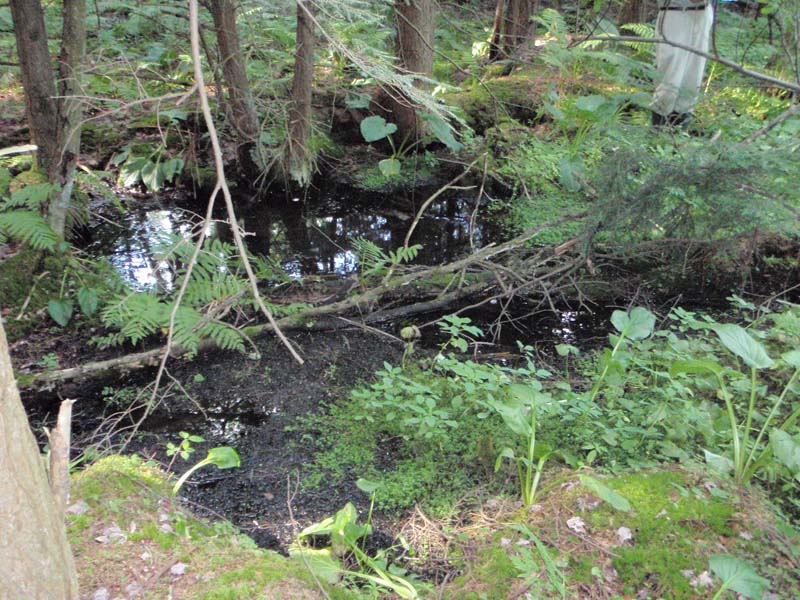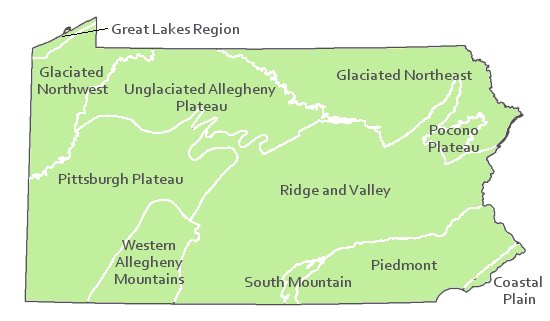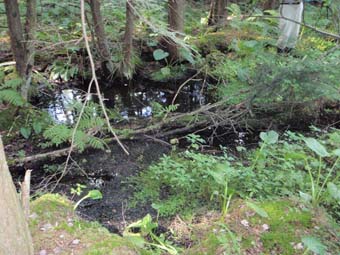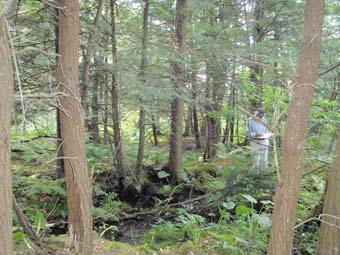Golden Saxifrage – Pennsylvania Bitter-cress Spring Run
System: Palustrine
Subsystem: Herbaceous
PA Ecological Group(s): Seepage Wetland
Global Rank:GNR
![]() rank interpretation
rank interpretation
State Rank: S3S4

General Description
This community occurs in and immediately adjacent to springs. Springs are places where groundwater flows to the surface, and eventually coalesces into a channel of flowing water. Water flow is relatively constant and uniform in temperature. Golden saxifrage (Chrysosplenium americanum), Pennsylvania bittercress (Cardamine pensylvanica), and the exotic species watercress (Nasturtium officinale) are often the most dominant plant species. Other species may include horsetails (Equisetum sp.), lettuce saxifrage (Saxifraga micranthidifolia), mountain watercress (Cardamine rotundifolia), and spring cress (Cardamine bulbosa). There is often high cover of bryophytes (mosses and liverworts) in and around the spring.
Rank Justification
Uncommon but not rare; some cause for long-term concern due to declines or other factors.
Identification
- Presence of a spring (ground-water fed upwelling of water coalescing to form a channel)
- Vegetation surrounding the spring is dominated by golden saxifrage (Chrysosplenium americanum), Pennsylvania bittercress (Cardamine pensylvanica), and/or the exotic species watercress (Nasturtium officinale).
Herbs
* limited to sites with higher soil calcium
Vascular plant nomenclature follows Rhoads and Block (2007). Bryophyte nomenclature follows Crum and Anderson (1981).
International Vegetation Classification Associations:
USNVC Crosswalk:None
Representative Community Types:
Golden-saxifrage Forested Seep (CEGL006193)
NatureServe Ecological Systems:
None
NatureServe Group Level:
None
Origin of Concept
Fike, J. 1999. Terrestrial and palustrine plant communities of Pennsylvania. Pennsylvania Natural Diversity Inventory. Pennsylvania Department of Conservation and Recreation, Bureau of Forestry, Harrisburg, PA. 86 pp.
Pennsylvania Community Code*
HS : Golden Saxifriage – Pennsylvania Bitter-Cress Spring Run
*(DCNR 1999, Stone 2006)
Similar Ecological Communities
Seep communities are differentiated from this spring run community because seepages are diffuse groundwater flow, while at a spring the groundwater flow coalesces into a recognizable channel. Generally the volume of springs is higher.
Fike Crosswalk
Golden Saxifrage – Pennsylvania Bitter-cress Spring Run
Conservation Value
The springs where the Golden Saxifrage – Pennsylvania Bittercress Spring Run community is found are valuable to aquatic habitat and water quality in-streams. Springs, which are fed by groundwater, are usually a source of clean water that flows at a relatively constant rate and temperature throughout the growing season. Springs help to maintain cool water temperatures, water quality, and constancy of flow in streams, which is valuable for aquatic ecosystems and human use.
Threats
The greatest threats to these communities are groundwater extraction and bedrock disruptions such as drilling or mining in nearby areas, which can contaminate or alter the flow patterns of the groundwater that feeds the seepage. Groundwater pollution can also occur from improperly installed septic systems, improperly lined underground waste disposal, and in agricultural areas, infiltration of pesticides, fertilizer, and bacteria from animal wastes. Removal of natural vegetation cover adjacent to the wetland can affect water levels and temperatures by increasing solar heating, surface run-off, and sedimentation. Invasive plant species can threaten the biological integrity of the community.
Management
Extraction, drilling, mining, or other activities that impact the bedrock or flow of groundwater should not be undertaken within half a mile of a spring run wetland without a thorough understanding of bedrock layers and groundwater flows. Groundwater flow patterns do not always mirror surface watersheds, and in some cases aquifers may be contiguous over large areas. Seepage wetlands are also sensitive to trampling and other physical disturbance from recreational activities; trails should be sited away from the wetland, or elevated structures employed to prevent traffic in the wetland. A natural buffer around the wetland should be maintained in order to minimize nutrient runoff, pollution, and sedimentation. The potential for soil erosion based on soil texture, condition of the adjacent vegetation (mature forests vs. clearcuts), and the topography of the surrounding area (i.e., degree of slope) should be considered when establishing buffers. The buffer size should be increased if soils are erodible, adjacent vegetation has been logged, and the topography is steep as such factors could contribute to increased sedimentation and nutrient pollution. Direct impacts and habitat alteration should be avoided (e.g., roads, trails, filling of wetlands) and low impact alternatives (e.g., elevated footpaths, boardwalks, bridges) should be utilized in situations where accessing the wetland cannot be avoided. Care should also be taken to control and prevent the spread of invasive species within the wetland. Alterations to groundwater sources should be minimized.
Research Needs
Groundwater flows are not well understood in many areas, and this information is very useful in managing seepage wetlands. Management may also be improved with a better understanding of natural successional pathways in these wetlands.
Trends
Specific information on the loss and degradation of springs is not available. Because springs generally provide a constant source of clean water, many have been developed for human use by the construction of a spring house or water spout. These modifications often result in vegetation removal, channelization or elimination of surface water flow.
Range Map

Pennsylvania Range
Statewide
Global Distribution
New Jersey, New York, and Pennsylvania
Byers, E. A., J. P. Vanderhorst, and B. P. Streets. 2007. Classification and conservation assessment of high elevation wetland communities in the Allegheny Mountains of West Virginia. West Virginia Natural Heritage Program, West Virginia Division of Natural Resources, Elkins.
CAP [Central Appalachian Forest Working Group]. 1998. Central Appalachian Working group discussions. The Nature Conservancy, Boston, MA.
Clancy, K. 1996. Natural communities of Delaware. Unpublished review draft. Delaware Natural Heritage Program, Division of Fish and Wildlife, Delaware Division of Natural Resources and Environmental Control, Smyrna, DE. 52 pp.
Cowardin, L. M., V. Carter, F. C. Golet, and E. T. LaRoe. 1979. Classification of wetlands and deepwater habitats of the United States. U.S. Fish and Wildlife Service, Biological Service Program. FWS/OBS-79/31. Washington, DC. 103 pp.
Dahl, T.E. 1990. Wetlands losses in the United States 1780's to 1980's. U.S. Department of the Interior, Fish and Wildlife Service. Washington, D.C. http://www.npwrc.usgs.gov/resource/othrdata/wetloss/wetloss.htm (Version 16JUL97).
Dahl, T.E. 2006. Status and trends of wetlands in the conterminous United States 1998 to 2004. U.S. Department of the Interior; Fish and Wildlife Service, Washington, D.C. 112 pp.
Eastern Ecology Working Group of NatureServe. No date. International Ecological Classification Standard: International Vegetation Classification. Terrestrial Vegetation. NatureServe, Boston, MA.
Edinger, G. J., D. J. Evans, S. Gebauer, T. G. Howard, D. M. Hunt, and A. M. Olivero, editors. 2002. Ecological communities of New York state. Second edition. A revised and expanded edition of Carol Reschke's ecological communities of New York state. (Draft for review). New York Natural Heritage Program, New York State Department of Environmental Conservation, Albany, NY.
Fike, J. 1999. Terrestrial and palustrine plant communities of Pennsylvania. Pennsylvania Natural Diversity Inventory. Pennsylvania Department of Conservation and Recreation. Bureau of Forestry. Harrisburg, PA. 86 pp.
Fleeger, G. M., 1999, The geology of Pennsylvania’s groundwater
(3rd ed.): Pennsylvania Geological Survey, 4th ser.,
Educational Series 3, 34 p. http://www.dcnr.state.pa.us/topogeo/education/es3.pdf
Gawler, S. C. 2002. Natural landscapes of Maine: A guide to vegetated natural communities and ecosystems. Maine Natural Areas Program, Department of Conservation, Augusta, ME. [in press]
Harrison, J. W., compiler. 2004. Classification of vegetation communities of Maryland: First iteration. A subset of the International Classification of Ecological Communities: Terrestrial Vegetation of the United States, NatureServe. Maryland Natural Heritage Program, Maryland Department of Natural Resources, Annapolis. 243 pp.
Helfrich, L.A., J. Parkhurst, and R. Neves. 2009. Managing spring wetlands for fish and wildlife habitat. Virginia Cooperative Extension publication 420-537. http://pubs.ext.vt.edu/420/420-537/420-537.html
Hill, A. F. 1923. The vegetation of the Penobscot Bay region, Maine. Proceedings of the Portland Society of Natural History 3:307-438.
NatureServe 2010. NatureServe Explorer: An online encyclopedia of life Version 7.1. NatureServe, Arlington, VA. Available http://www.natureserv.org/explorer (accessed: 23 November 2011).
Northern Appalachian Ecology Working Group. 2000. Northern Appalachian / Boreal Ecoregion community classification (Review Draft). The Nature Conservancy, Eastern Conservation Science Center, Boston, MA. 117 pp. plus appendices.
Pennsylvania Department of Conservation and Natural Resources (DCNR). 1999. Inventory Manual of Procedure. For the Fourth State Forest Management Plan. Pennsylvania Bureau of Forestry, Division of Forest Advisory Service. Harrisburg, PA. 51 ppg.
Sperduto, D. D. 2000b. A classification of wetland natural communities in New Hampshire. New Hampshire Natural Heritage Inventory, Department of Resources and Economic Development, Division of Forests and Lands. Concord, NH. 156 pp.
Stone, B., D. Gustafson, and B. Jones. 2006 (revised). Manual of Procedure for State Game Land Cover Typing. Commonwealth of Pennsylvania Game Commission, Bureau of Wildlife Habitat Management, Forest Inventory and Analysis Section, Forestry Division. Harrisburg, PA. 79 ppg.
Swain, P. C., and J. B. Kearsley. 2000. Classification of natural communities of Massachusetts. July 2000 draft. Natural Heritage and Endangered Species Program, Massachusetts Division of Fisheries and Wildlife. Westborough, MA.
Thompson, E. 1996. Natural communities of Vermont uplands and wetland. Nongame and Natural Heritage Program, Department of Fish and Wildlife in cooperation with The Nature Conservancy, Vermont chapter. 34 pp.
Thompson, E. H., and E. R. Sorenson. 2000. Wetland, woodland, wildland: A guide to the natural communities of Vermont. The Nature Conservancy and the Vermont Department of Fish and Wildlife. University Press of New England, Hanover, NH. 456 pp.
Tiner, R.W. 1990. Pennsylvania’s Wetlands: Current Status and Recent Trends. U. S. Fish and Wildlife Service report, 104 pp.
Cite as:
Mcpherson, J. 2022. Pennsylvania Natural Heritage Program. Golden Saxifrage – Pennsylvania Bitter-cress Spring Run Factsheet. Available from: https://naturalheritage.state.pa.us/Community.aspx?=16004 Date Accessed: March 28, 2025









